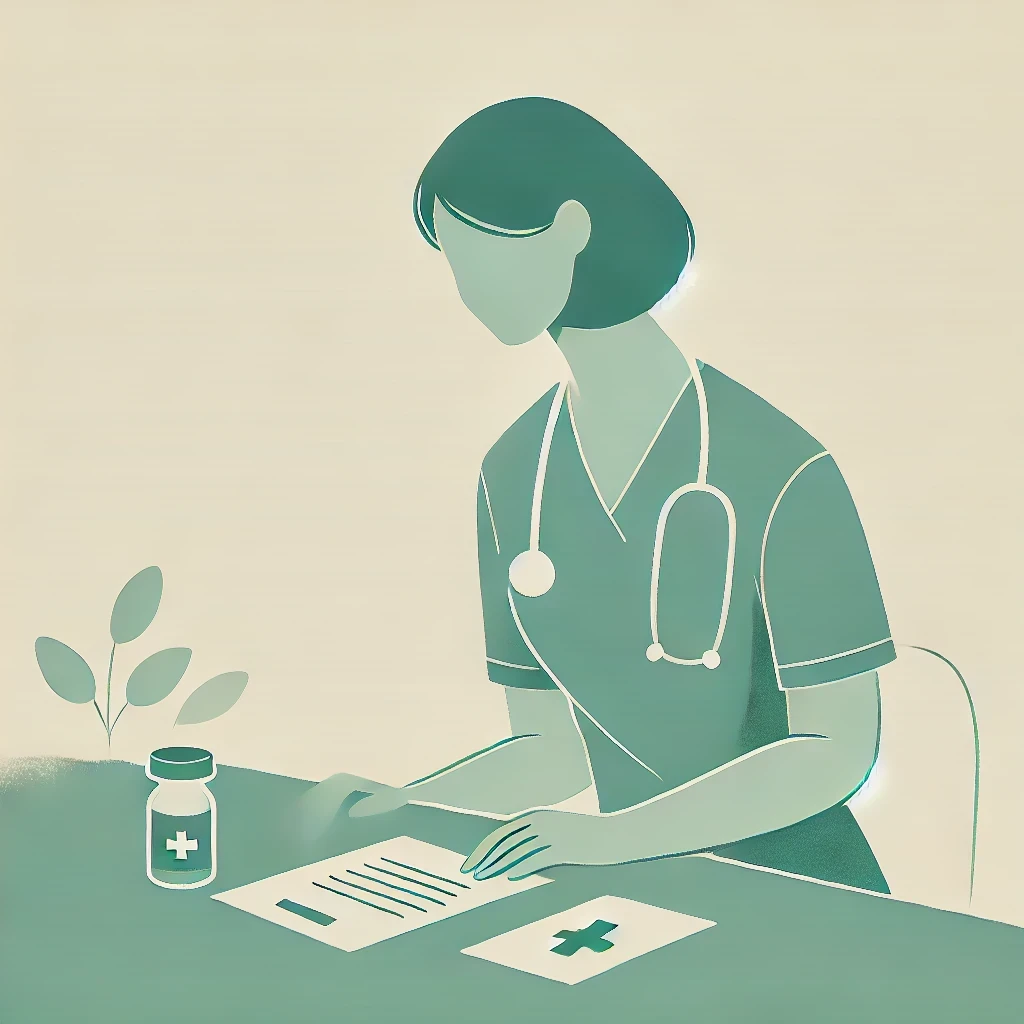
Published in Trauma's Impact

Erin Berenz
Trauma Psychologist / Cofounder of Rebound
February 18, 2025
Why Nurses Experience Such High Rates of CPTSD and PTSD
If you’re a nurse, you know your job is more than just a profession—it’s a deep responsibility that stays with you, sometimes long after a shift ends.
Day in and day out, nurses face intense, high-stakes situations, often with little time to process the emotional toll. Studies show that PTSD rates among nurses are 3 to 6 times higher than those of the general population, with prevalence reaching 20-30% in high-intensity settings like the ICU and ER (Mealer et al., 2009). The COVID-19 pandemic only made things worse, pushing many nurses past their breaking point (Galanis et al., 2024).
But here’s the truth: Nurses deserve the same care and support they give to everyone else. It’s time to change the narrative and recognize the mental health challenges that come with this profession.
The Nature of Nursing: A Front-Row Seat to Trauma
As a nurse, you witness patients in their most vulnerable moments. Whether it’s a sudden emergency, the loss of a patient, or comforting a family receiving devastating news, you’re immersed in emotionally charged situations every single day.
This repeated exposure to trauma can have a cumulative effect on your mental health. Even when you’re not the direct victim of trauma, witnessing it over and over can lead to secondary traumatic stress, a significant contributor to PTSD and CPTSD (Schuster & Dwyer, 2020).
Why Nurses Are at Higher Risk
Several factors put nurses at greater risk for PTSD and CPTSD compared to other professions:
🔹 Workplace Stress & Burnout – Long shifts, understaffing, and high patient loads leave little room for rest or emotional recovery.
🔹 Moral Injury – When you can’t provide the level of care your patients deserve due to systemic issues, it can leave lasting emotional wounds (Oe et al., 2022).
🔹 Exposure to Death & Dying – Nurses frequently witness loss and grief, which can accumulate over time.
🔹 Personal Sacrifices – Putting patients first often means neglecting self-care, making it harder to manage stress.
When Past and Present Trauma Collide
For many nurses, the stress of the job is only one piece of the puzzle.
Studies suggest that healthcare workers have higher rates of childhood trauma than the general population (Mealer et al., 2007). For some, a nursing career is a way to leave behind a difficult past and build financial independence. Others may have naturally stepped into caregiving roles early in life, making nursing feel like a continuation of something deeply familiar.
But when past trauma meets workplace trauma, it can reinforce survival mode—making it hard to turn off hypervigilance, manage emotional overwhelm, or feel truly safe.
Signs You Might Be Stuck in Survival Mode:
✅ Persistent feelings of helplessness or despair
✅ Difficulty trusting others
✅ Emotional numbness or disconnection
✅ Flashbacks or intrusive thoughts
✅ Hypervigilance or a constant sense of danger
Compounding these challenges is the unspoken expectation in nursing to “stay strong” and push through. Without space to process emotions, distress can build up over time, increasing the risk of PTSD or CPTSD.
Breaking the Silence
One of the biggest barriers to getting help? The stigma surrounding mental health in the nursing profession.
If you’ve ever felt pressure to just keep going—despite exhaustion, grief, or trauma—you’re not alone. But healing starts with recognizing that PTSD and CPTSD are not signs of weakness. They are human responses to extraordinary stress.
Talking openly about mental health with trusted colleagues, a therapist, or a peer support group can help break the cycle of isolation and shame.
Steps Toward Healing
💡 Recognize the Signs – Awareness is the first step toward change. If you notice symptoms of PTSD or CPTSD, take them seriously.
💡 Seek Help – Trauma-focused methods, such as CBT, EMDR, or Rebound, can be highly effective in helping nurses recover from PTSD (Zhang et al., 2022).
💡 Prioritize Self-Care – While self-care isn’t a cure, it’s essential for managing stress. Small but consistent actions—like mindfulness, exercise, or setting better boundaries—can help.
💡 Advocate for Systemic Change – Nurses have the power to push for workplace improvements, like peer support programs, mental health resources, and policy changes to reduce burnout.
You Deserve Support
As a nurse, you give so much of yourself to care for others. But your mental health matters, too.
PTSD and CPTSD aren’t just statistics—they’re lived realities for many nurses. If you’re struggling, you are not alone, and help is available. Taking care of yourself isn’t just necessary—it’s an act of courage.
Because healing isn’t just for patients. It’s for you, too.
References
Mealer M, Burnham EL, Goode CJ, Rothbaum B, Moss M. (2009). The prevalence and impact of PTSD and burnout in nurses. Depress Anxiety, 26(12), 1118-1126.
Mealer ML, Shelton A, Berg B, Rothbaum B, Moss M. (2007). Increased prevalence of PTSD symptoms in critical care nurses. Am J Respir Crit Care Med, 175(7), 693-697.
Oe M, Maeda M, Ohira T, et al. (2022). Associations between moral injury and PTSD in treatment-seeking nurses. BMJ Open, 12(5), e060134. BMJ
Zhang Y, Wang C, Pan W, et al. (2022). PTSD prevalence among healthcare workers during COVID-19. Front Psychiatry, 13, 803514.
Schuster M, Dwyer PA. (2020). PTSD in nurses: An integrative review. J Clin Nurs, 29(15-16), 2769-2787.
Galanis P, Vraka I, Fragkou D, Bilali A, Kaitelidou D. (2024). PTSD symptoms among nurses during COVID-19: A meta-analysis. Int J Nurs Stud, 140, 104569.
Day in and day out, nurses face intense, high-stakes situations, often with little time to process the emotional toll. Studies show that PTSD rates among nurses are 3 to 6 times higher than those of the general population, with prevalence reaching 20-30% in high-intensity settings like the ICU and ER (Mealer et al., 2009). The COVID-19 pandemic only made things worse, pushing many nurses past their breaking point (Galanis et al., 2024).
But here’s the truth: Nurses deserve the same care and support they give to everyone else. It’s time to change the narrative and recognize the mental health challenges that come with this profession.
The Nature of Nursing: A Front-Row Seat to Trauma
As a nurse, you witness patients in their most vulnerable moments. Whether it’s a sudden emergency, the loss of a patient, or comforting a family receiving devastating news, you’re immersed in emotionally charged situations every single day.
This repeated exposure to trauma can have a cumulative effect on your mental health. Even when you’re not the direct victim of trauma, witnessing it over and over can lead to secondary traumatic stress, a significant contributor to PTSD and CPTSD (Schuster & Dwyer, 2020).
Why Nurses Are at Higher Risk
Several factors put nurses at greater risk for PTSD and CPTSD compared to other professions:
🔹 Workplace Stress & Burnout – Long shifts, understaffing, and high patient loads leave little room for rest or emotional recovery.
🔹 Moral Injury – When you can’t provide the level of care your patients deserve due to systemic issues, it can leave lasting emotional wounds (Oe et al., 2022).
🔹 Exposure to Death & Dying – Nurses frequently witness loss and grief, which can accumulate over time.
🔹 Personal Sacrifices – Putting patients first often means neglecting self-care, making it harder to manage stress.
When Past and Present Trauma Collide
For many nurses, the stress of the job is only one piece of the puzzle.
Studies suggest that healthcare workers have higher rates of childhood trauma than the general population (Mealer et al., 2007). For some, a nursing career is a way to leave behind a difficult past and build financial independence. Others may have naturally stepped into caregiving roles early in life, making nursing feel like a continuation of something deeply familiar.
But when past trauma meets workplace trauma, it can reinforce survival mode—making it hard to turn off hypervigilance, manage emotional overwhelm, or feel truly safe.
Signs You Might Be Stuck in Survival Mode:
✅ Persistent feelings of helplessness or despair
✅ Difficulty trusting others
✅ Emotional numbness or disconnection
✅ Flashbacks or intrusive thoughts
✅ Hypervigilance or a constant sense of danger
Compounding these challenges is the unspoken expectation in nursing to “stay strong” and push through. Without space to process emotions, distress can build up over time, increasing the risk of PTSD or CPTSD.
Breaking the Silence
One of the biggest barriers to getting help? The stigma surrounding mental health in the nursing profession.
If you’ve ever felt pressure to just keep going—despite exhaustion, grief, or trauma—you’re not alone. But healing starts with recognizing that PTSD and CPTSD are not signs of weakness. They are human responses to extraordinary stress.
Talking openly about mental health with trusted colleagues, a therapist, or a peer support group can help break the cycle of isolation and shame.
Steps Toward Healing
💡 Recognize the Signs – Awareness is the first step toward change. If you notice symptoms of PTSD or CPTSD, take them seriously.
💡 Seek Help – Trauma-focused methods, such as CBT, EMDR, or Rebound, can be highly effective in helping nurses recover from PTSD (Zhang et al., 2022).
💡 Prioritize Self-Care – While self-care isn’t a cure, it’s essential for managing stress. Small but consistent actions—like mindfulness, exercise, or setting better boundaries—can help.
💡 Advocate for Systemic Change – Nurses have the power to push for workplace improvements, like peer support programs, mental health resources, and policy changes to reduce burnout.
You Deserve Support
As a nurse, you give so much of yourself to care for others. But your mental health matters, too.
PTSD and CPTSD aren’t just statistics—they’re lived realities for many nurses. If you’re struggling, you are not alone, and help is available. Taking care of yourself isn’t just necessary—it’s an act of courage.
Because healing isn’t just for patients. It’s for you, too.
References
Mealer M, Burnham EL, Goode CJ, Rothbaum B, Moss M. (2009). The prevalence and impact of PTSD and burnout in nurses. Depress Anxiety, 26(12), 1118-1126.
Mealer ML, Shelton A, Berg B, Rothbaum B, Moss M. (2007). Increased prevalence of PTSD symptoms in critical care nurses. Am J Respir Crit Care Med, 175(7), 693-697.
Oe M, Maeda M, Ohira T, et al. (2022). Associations between moral injury and PTSD in treatment-seeking nurses. BMJ Open, 12(5), e060134. BMJ
Zhang Y, Wang C, Pan W, et al. (2022). PTSD prevalence among healthcare workers during COVID-19. Front Psychiatry, 13, 803514.
Schuster M, Dwyer PA. (2020). PTSD in nurses: An integrative review. J Clin Nurs, 29(15-16), 2769-2787.
Galanis P, Vraka I, Fragkou D, Bilali A, Kaitelidou D. (2024). PTSD symptoms among nurses during COVID-19: A meta-analysis. Int J Nurs Stud, 140, 104569.
Day in and day out, nurses face intense, high-stakes situations, often with little time to process the emotional toll. Studies show that PTSD rates among nurses are 3 to 6 times higher than those of the general population, with prevalence reaching 20-30% in high-intensity settings like the ICU and ER (Mealer et al., 2009). The COVID-19 pandemic only made things worse, pushing many nurses past their breaking point (Galanis et al., 2024).
But here’s the truth: Nurses deserve the same care and support they give to everyone else. It’s time to change the narrative and recognize the mental health challenges that come with this profession.
The Nature of Nursing: A Front-Row Seat to Trauma
As a nurse, you witness patients in their most vulnerable moments. Whether it’s a sudden emergency, the loss of a patient, or comforting a family receiving devastating news, you’re immersed in emotionally charged situations every single day.
This repeated exposure to trauma can have a cumulative effect on your mental health. Even when you’re not the direct victim of trauma, witnessing it over and over can lead to secondary traumatic stress, a significant contributor to PTSD and CPTSD (Schuster & Dwyer, 2020).
Why Nurses Are at Higher Risk
Several factors put nurses at greater risk for PTSD and CPTSD compared to other professions:
🔹 Workplace Stress & Burnout – Long shifts, understaffing, and high patient loads leave little room for rest or emotional recovery.
🔹 Moral Injury – When you can’t provide the level of care your patients deserve due to systemic issues, it can leave lasting emotional wounds (Oe et al., 2022).
🔹 Exposure to Death & Dying – Nurses frequently witness loss and grief, which can accumulate over time.
🔹 Personal Sacrifices – Putting patients first often means neglecting self-care, making it harder to manage stress.
When Past and Present Trauma Collide
For many nurses, the stress of the job is only one piece of the puzzle.
Studies suggest that healthcare workers have higher rates of childhood trauma than the general population (Mealer et al., 2007). For some, a nursing career is a way to leave behind a difficult past and build financial independence. Others may have naturally stepped into caregiving roles early in life, making nursing feel like a continuation of something deeply familiar.
But when past trauma meets workplace trauma, it can reinforce survival mode—making it hard to turn off hypervigilance, manage emotional overwhelm, or feel truly safe.
Signs You Might Be Stuck in Survival Mode:
✅ Persistent feelings of helplessness or despair
✅ Difficulty trusting others
✅ Emotional numbness or disconnection
✅ Flashbacks or intrusive thoughts
✅ Hypervigilance or a constant sense of danger
Compounding these challenges is the unspoken expectation in nursing to “stay strong” and push through. Without space to process emotions, distress can build up over time, increasing the risk of PTSD or CPTSD.
Breaking the Silence
One of the biggest barriers to getting help? The stigma surrounding mental health in the nursing profession.
If you’ve ever felt pressure to just keep going—despite exhaustion, grief, or trauma—you’re not alone. But healing starts with recognizing that PTSD and CPTSD are not signs of weakness. They are human responses to extraordinary stress.
Talking openly about mental health with trusted colleagues, a therapist, or a peer support group can help break the cycle of isolation and shame.
Steps Toward Healing
💡 Recognize the Signs – Awareness is the first step toward change. If you notice symptoms of PTSD or CPTSD, take them seriously.
💡 Seek Help – Trauma-focused methods, such as CBT, EMDR, or Rebound, can be highly effective in helping nurses recover from PTSD (Zhang et al., 2022).
💡 Prioritize Self-Care – While self-care isn’t a cure, it’s essential for managing stress. Small but consistent actions—like mindfulness, exercise, or setting better boundaries—can help.
💡 Advocate for Systemic Change – Nurses have the power to push for workplace improvements, like peer support programs, mental health resources, and policy changes to reduce burnout.
You Deserve Support
As a nurse, you give so much of yourself to care for others. But your mental health matters, too.
PTSD and CPTSD aren’t just statistics—they’re lived realities for many nurses. If you’re struggling, you are not alone, and help is available. Taking care of yourself isn’t just necessary—it’s an act of courage.
Because healing isn’t just for patients. It’s for you, too.
References
Mealer M, Burnham EL, Goode CJ, Rothbaum B, Moss M. (2009). The prevalence and impact of PTSD and burnout in nurses. Depress Anxiety, 26(12), 1118-1126.
Mealer ML, Shelton A, Berg B, Rothbaum B, Moss M. (2007). Increased prevalence of PTSD symptoms in critical care nurses. Am J Respir Crit Care Med, 175(7), 693-697.
Oe M, Maeda M, Ohira T, et al. (2022). Associations between moral injury and PTSD in treatment-seeking nurses. BMJ Open, 12(5), e060134. BMJ
Zhang Y, Wang C, Pan W, et al. (2022). PTSD prevalence among healthcare workers during COVID-19. Front Psychiatry, 13, 803514.
Schuster M, Dwyer PA. (2020). PTSD in nurses: An integrative review. J Clin Nurs, 29(15-16), 2769-2787.
Galanis P, Vraka I, Fragkou D, Bilali A, Kaitelidou D. (2024). PTSD symptoms among nurses during COVID-19: A meta-analysis. Int J Nurs Stud, 140, 104569.
About Rebound
Rebound is an app designed to help you recover after trauma. It was built by trauma survivors and psychologists to help your brain and body get out of Survival Mode.
Continue Reading
